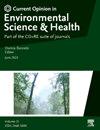全氟和多氟烷基物质:新出现的环境挑战和(微生物)生物电化学处理策略
IF 6.6
Q1 ENVIRONMENTAL SCIENCES
Current Opinion in Environmental Science and Health
Pub Date : 2025-02-01
DOI:10.1016/j.coesh.2024.100588
引用次数: 0
摘要
全氟烷基和多氟烷基物质(PFAS)在土壤、沉积物和水中的积累,由于其持久性和潜在毒性,构成重大的公共健康风险。PFAS化合物具有很强的C - F键,需要非常高的能量才能打破,这使得目前的技术不可持续,并且对大规模处理具有挑战性。最近对PFAS微生物降解机理的研究为其可持续降解提供了有希望的解决方案。具体来说,生物电化学系统可以利用导电阳极电极上电活性微生物产生的高能电子有效地破坏PFAS中的强C - F键,达到高达96%的惊人去除效率。然而,这些系统仍处于实验阶段,需要进一步优化才能成功地大规模应用。这篇简明而详细的综述旨在加强对PFAS作为一种普遍有效的化学物质的出现、微生物辅助降解机制和微生物群落分析的理解,指导未来的研究和政策制定,以改善公共卫生和环境管理。本文章由计算机程序翻译,如有差异,请以英文原文为准。

Per- and polyfluoroalkyl substances (PFAS): An emerging environmental challenge and (microbial)bioelectrochemical treatment strategies
Accumulation of per- and polyfluoroalkyl substances (PFAS) in soil, sediment, and water poses significant public health risks due to their persistence and potential toxicity. PFAS compound possesses strong C – F bonds that require very high energy to break, making current technology unsustainable and challenging for large-scale treatment. Recent mechanistic insights into microbial degradation of PFAS offer promising solutions for their sustainable degradation. Specifically, bioelectrochemical systems can effectively break the strong C – F bonds in PFAS using high-energy electrons generated from electroactive microbes at a conductive anode electrode, achieving an astonishing removal efficiency of up to 96 %. However, these systems are still experimental, requiring further optimization for successful large-scale applications. This concise yet detailed review aims to enhance understanding of the emergence of PFAS as a pervasive potent chemical, microbe-assisted degradation mechanisms, and microbial community analysis, guiding future research and policy development for improved public health and environmental management.
求助全文
通过发布文献求助,成功后即可免费获取论文全文。
去求助
来源期刊

Current Opinion in Environmental Science and Health
Medicine-Public Health, Environmental and Occupational Health
CiteScore
14.90
自引率
0.00%
发文量
92
审稿时长
114 days
 求助内容:
求助内容: 应助结果提醒方式:
应助结果提醒方式:


